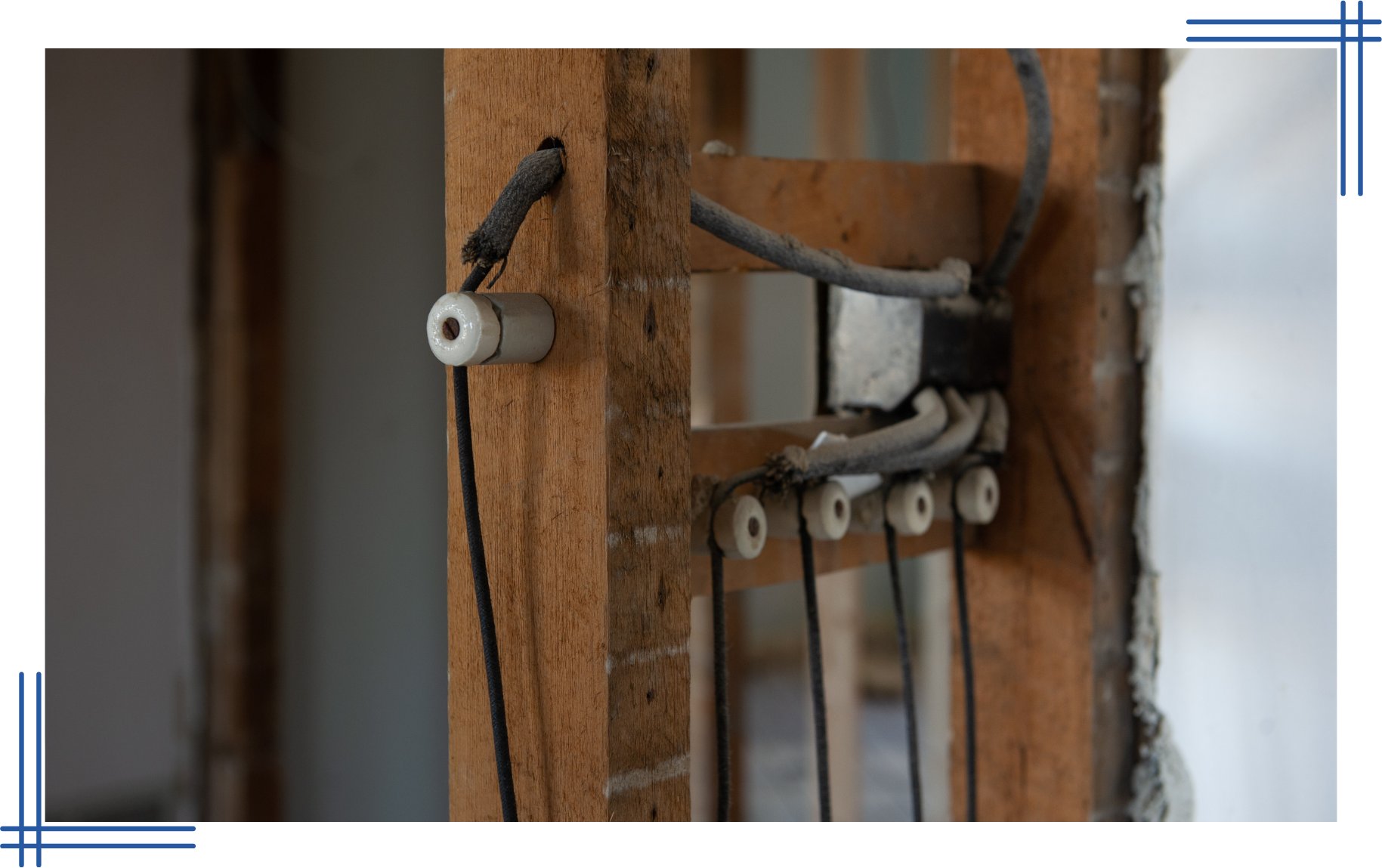
Slide title
Write your caption hereButton
Knob And Tube Wiring Services

Slide title
Write your caption hereButton
Knob And Tube Wiring Services
Knob and tube wiring, a relic of the past, was once a common sight in many homes built before the 1950s. This method of electrical wiring involves a network of ceramic knobs and tubes, which support and protect insulated copper wires. At the time of its introduction, it was considered an effective and reliable option for electrical wiring. However, as the standards of safety and efficiency have evolved, this system has become notably outdated and inadequate for modern electrical demands.
Unlike modern wiring systems that are enclosed and insulated, knob and tube wiring utilized open-air as its primary form of insulation. This method relied on the surrounding air to cool the wires, a concept quite alien to today's standards where wires are closely packed and heavily insulated. Second, this type of wiring does not include a ground wire, a now-standard feature in electrical systems. Lastly, the ceramic knobs and tubes used in this system were designed to prevent the wires from touching the wood and other combustible materials in a building's structure, serving as early fire prevention measures—though, by today's standards, not nearly enough to be considered safe or efficient.
Associated Risks
One of the most critical flaws in knob and tube wiring is its lack of a grounding conductor. Modern electrical systems are equipped with grounding to protect against accidental shocks and to help prevent electrical fires. Without this essential feature, knob and tube systems are significantly more prone to causing electrical shocks. This ungrounded system is not only a hazard in terms of personal safety but also increases the risk of electrical fires, as any fault in the system could lead to a direct path of electricity that can ignite flammable materials nearby.
The insulation, primarily made from rubber or cloth, is susceptible to degradation over time. As these materials age, they can become brittle and break away from the wires, leaving the conductive copper exposed. This deterioration substantially elevates the risk of short circuits and fires, especially in environments where wires are hidden within walls, attics, or basements, areas that may accumulate dust or other flammable materials.
The system's inability to cope with the electrical demands of modern households further complicates its viability. Designed during a time when few electrical appliances were used within homes, knob and tube wiring is not capable of supporting today's average electrical load. Modern homes require robust systems that can handle multiple appliances running simultaneously — from refrigerators and washing machines to computers and televisions. When overloaded, the wiring can overheat, which not only poses a fire hazard but also threatens the overall electrical integrity of the home.
Insurance companies often view homes with knob and tube wiring as high-risk properties. This perception stems from the increased potential for electrical fires and safety hazards associated with the outdated system. As a result, homeowners may encounter difficulties obtaining insurance coverage. Even if they do manage to secure insurance, it typically comes at a much higher premium. In some cases, insurance providers may require that the wiring be replaced or updated as a condition of coverage, adding an immediate financial burden to maintain insurance validity.
Knob and tube wiring can also significantly affect the resale value of a home. During the home inspection process, potential buyers are likely to view existing knob and tube wiring as a major drawback. This is due to the anticipated costs and effort involved in updating the electrical system. Consequently, homes with this type of wiring often see a reduction in market value and may take longer to sell.
Regulatory And Technological Requirements
Compliance with the National Electrical Code (NEC) and local building codes is another critical consideration. The NEC sets the standard for safe electrical design, installation, and inspection to protect people and property from electrical hazards. Knob and tube wiring, being an older installation, often does not meet current NEC standards, which continually evolve to incorporate new safety technologies and methods. Homeowners may find themselves legally required to replace or significantly update their electrical systems during renovations or when making significant repairs. Additionally, local building codes may have specific requirements or restrictions regarding knob and tube wiring, necessitating professional consultation and potential system overhauls to remain compliant.
Modern electrical systems are far more efficient than their outdated counterparts. They are designed to reduce energy wastage, which can lead to lower utility bills and a smaller carbon footprint. Furthermore, these systems can handle the increased electrical demands of modern households, which typically include a variety of gadgets and appliances that require stable and continuous power. By upgrading their wiring, homeowners can enjoy the benefits of advanced technology without the risk of overloading their system, which is a common problem with knob and tube wiring.
Don't wait until you face the consequences of an outdated system. By choosing Summit Electrical Solutions for your electrical upgrades, you are not only safeguarding your property against potential hazards but also enhancing its overall value and functionality. We offer comprehensive consultations to assess your current electrical system, provide detailed plans for upgrades, and carry out the installation with minimal disruption to your daily life.
Contact Summit Electrical Solutions today to schedule your consultation.
Frequently Asked Questions
Q1: What historical period saw the widespread use of knob and tube wiring in residential construction?
A1: It was predominantly installed in homes from the 1880s until the 1930s. It was one of the earliest standardized methods of electrical wiring implemented as electricity became more accessible in residential areas.
Q2: Why did knob and tube wiring not include a ground wire, and what implications does this have for safety?
A2: It was designed before grounding was a standard safety protocol in electrical systems. The absence of a ground wire means that this type of wiring is more susceptible to causing electrical shocks and fires, especially if the insulation degrades or if it's improperly handled.
Q3: What were the initial advantages of knob and tube wiring that led to its widespread adoption in the early 20th century?
A3: It was initially favored because it was less expensive and simpler to install compared to other methods available at the time. Its design allowed for easy access and air cooling, which were considered innovative for managing heat and preventing fire risks in the early days of residential electricity.
All Rights Reserved | Summit Electrical Solutions
